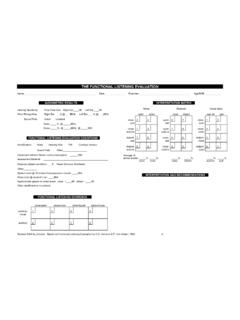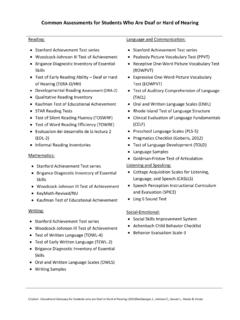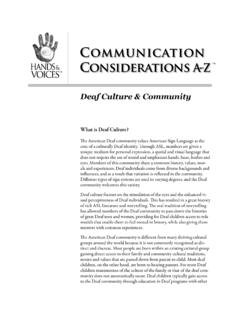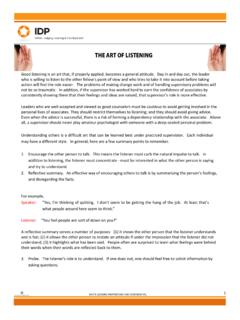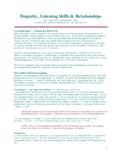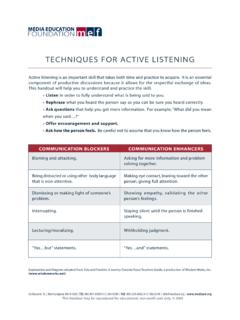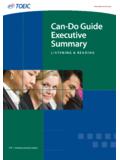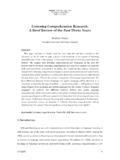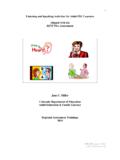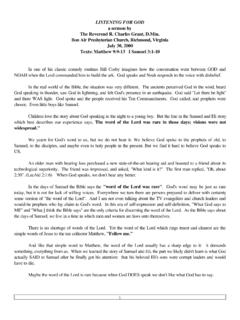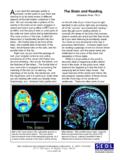Transcription of THE FUNCTIONAL LISTENING EVALUATION
1 Revised 2004 by Johnson. Based on FUNCTIONAL LISTENING EVALUATION by Johnson & P. Von Almen, 1993. 1 THE FUNCTIONAL LISTENING EVALUATION Purpose of the FUNCTIONAL LISTENING EVALUATION The purpose of this EVALUATION is to determine how LISTENING abilities are affected by noise, distance, and visual input in an individual s natural LISTENING environment. It is designed to simulate LISTENING ability in situations that are more representative of actual LISTENING conditions than can often be replicated in sound booth assessment. Through observation of the administration of the EVALUATION , the student s teachers, parents, and others may gain appreciation of the affects of adverse LISTENING conditions encountered by the student. The EVALUATION results are also useful in justifying accommodations, such as assistive LISTENING devices, sign language or oral interpreters, notetakers, captioning, special seating, and room acoustic modifications.
2 This protocol is based on a LISTENING paradigm suggested by Ying (1990), and by Ross, Bracken, and Maxon (1992). Materials Needed Cassette Tape Recorder or CD player Sound Level Meter - use A weighted scale (can be purchased inexpensively from Radio Shack) Noise Tape or CD - Multitalker is recommended (available from Auditec) Tripod or stand to hold sound level meter (optional) Word/Phrase/Sentence Lists for test stimuli Tape measure or yard stick Masking tape or marker (optional) Environment for Testing Use the student s classroom during a time when it is empty. If this is not possible, choose a room that most closely approximates the size, ambient noise level, and floor and wall surfaces of the student s classroom. While performance during actual class sessions would seem ideal, the test process itself may be disruptive to instruction for the rest of the class and may not reflect the adverse conditions encountered by the student throughout the day.
3 Physical Set-up of Test Environment Due to room size and instructional style variations, the occupied classroom should be observed to determine maximum LISTENING distances. The distance used should be recorded on the scoring form. These distances can be marked using masking tape on the floor. Be sure that the markers are from the student s ear to the examiner s mouth. Close: Noise and examiner are 3 feet in front of the student (see Diagram A). Distant: Noise remains 3 feet in front of the student; examiner moves back to the pre-determined distance [12 to 15 feet in this example] from the student (see Diagram B). Diagram A. Diagram B. 3 FT 3 FT 12-15 FT STUDENT STUDENT NOISE TAPE EXAMINER NOISE TAPE EXAMINER Revised 2004 by Johnson.
4 Based on FUNCTIONAL LISTENING EVALUATION by Johnson & P. Von Almen, 1993. 2 Types of EVALUATION Materials In order to simulate classroom LISTENING ability, the EVALUATION material utilized should approximate material that is encountered by the student in the classroom. Additionally the stimuli should have sufficient length to reflect reverberation characteristics of the room. Consideration should also be given to both familiar and new material that a student may encounter. Individuals will usually perform better with familiar material than with stimuli containing unfamiliar vocabulary. Individuals with unilateral and mild hearing losses tend to perform well under all conditions due to the audibility and inherent redundancy in phrase and sentence material utilizing familiar vocabulary.
5 Nonsense phrases have been constructed to decrease these performance effects. Age, limited language, and memory abilities of the individual should also be considered when determining the test stimuli. In selecting word, phrase or sentence materials, consider whether the vocabulary and syntax are appropriate for the student s language ability. For students with poor speech intelligibility, it may be necessary to use materials that permit picture-pointing responses. If closed-set materials are utilized, performance can be expected to be better than with open-set materials. Once the type of stimuli is determined, it must remain constant throughout the assessment so that the variables manipulated are noise, distance, and visual input. Report the material used on the scoring form.
6 Sentence Materials: BLAIR Sentences WIPI Sentences SPIN Sentences(older students) BKB Sentences PSI Sentences Phrase Materials: Common Children s Phrases Children s Nonsense Phrases Word Lists: B-K NU-CHIPS WIPI Note: BLAIR, SPIN, WIPI, PSI, BKB sentences and the Common Children s Phrases are reproduced in the Educational Audiology Handbook (Johnson, Benson, & Seaton, 1997); Children s Nonsense Phrases are available from the author; word lists are available through any audiologist. In many of the above materials there will not be enough lists for the entire protocol (8 lists are needed).
7 If it is necessary to use a list twice, select the lists that were more difficult for the student in order to reduce familiarity with the material. Presentation Levels Speech to noise ratios should be based upon the auditory environment encountered by the student in the classroom. Sound level measurements of classroom discourse and activity may be necessary to determine these levels. For this example, levels will achieve approximate values of a +5 dB speech to noise ratio in the close condition and a 5dB speech to noise ratio in the distant condition (12-15ft). Levels will vary slightly depending upon the acoustics of the room and consistency of the speaker s voicing of the stimuli. Record the classroom ambient noise level (unoccupied) and approximate speech and noise levels on the scoring form.
8 Speech: Monitor speaker s voice with the sound level meter so that speech averages 71dBSPL at 18 inches from the examiner s mouth (will be about 65dBA at listener s ear for close conditions). Noise: Adjust volume of cassette or CD player, which is 3 feet from the student, using the sound level meter so that the multitalker noise averages 60 dBA at the student s ear. Presentation Protocol The EVALUATION should be conducted in the student s typical hearing mode. If hearing aids are usually worn at school, they should also be worn during the EVALUATION . This EVALUATION can also be used to demonstrate the improved LISTENING ability with FM or other assistive amplification, whether personal or sound field. Eight sentence or word lists should be presented in the order indicated by the numbers on the scoring matrix.
9 This order balances for difficulty across conditions so that the final task is the easiest of the distance conditions. The examiner may choose to alter the order for other reasons however. Revised 2004 by Johnson. Based on FUNCTIONAL LISTENING EVALUATION by Johnson & P. Von Almen, 1993. 3 The examiner should present the speech materials at a normal speaking rate. The student repeats the test stimuli or points to the appropriate picture, as dictated by the material used. Test administration takes approximately 30 minutes, including set up, with sentences and 20 minutes with words. 1. Auditory-Visual Close Quiet 2. Auditory Close Quiet 3. Auditory-Visual Close Noise 4.
10 Auditory Close Noise 5. Auditory-Visual Distant Noise 6. Auditory Distant Noise 7. Auditory Distant Quiet 8. Auditory-Visual Distant Quiet Scoring Scoring should be completed using the protocol established for the selected test materials. All scores should be reported in percent correct in the Scorebox. Variations in Protocol This protocol is based on the LISTENING situation of a typical classroom. For an individual student, it may be useful to modify this protocol to account for variations in the level and source of noise, classroom size, teacher s voice, typical LISTENING distances for the student, or other factors.
